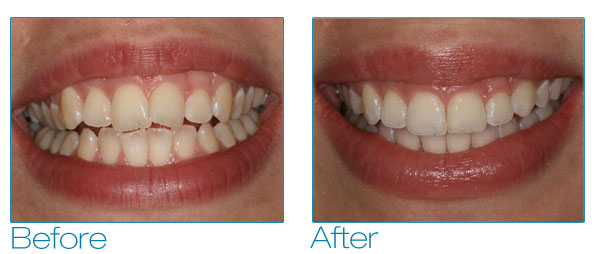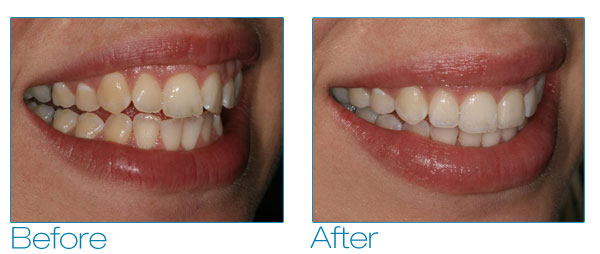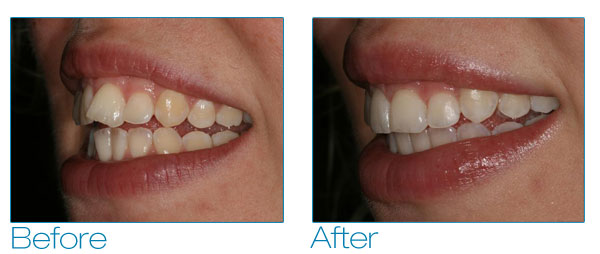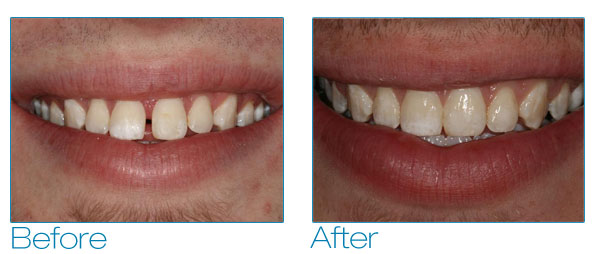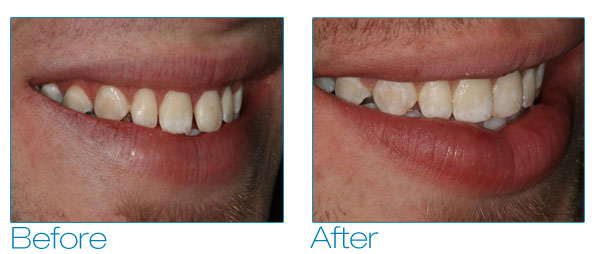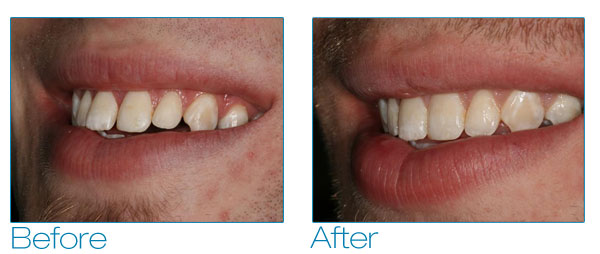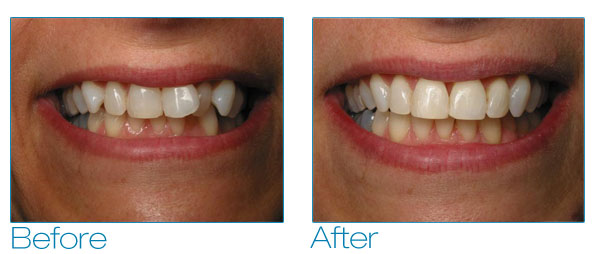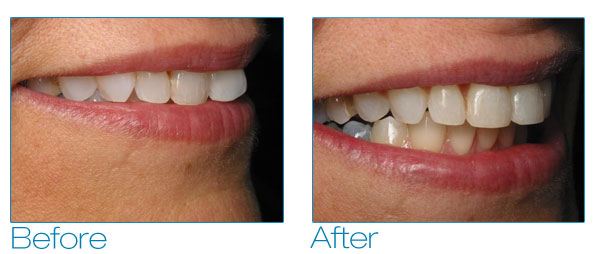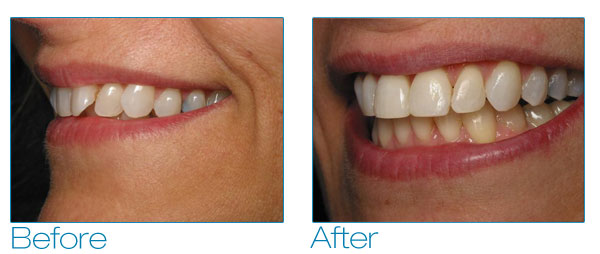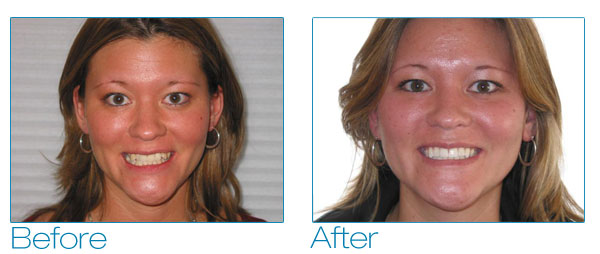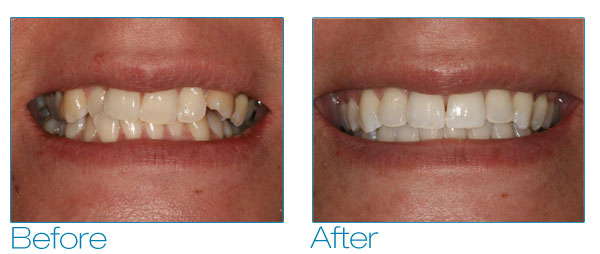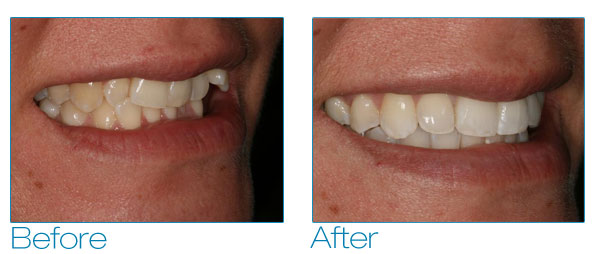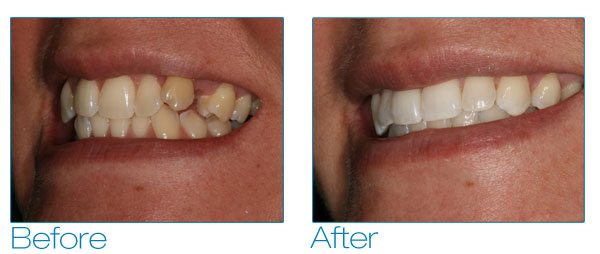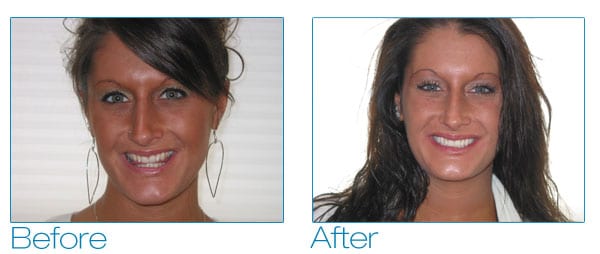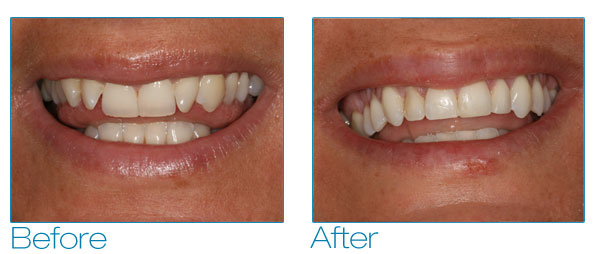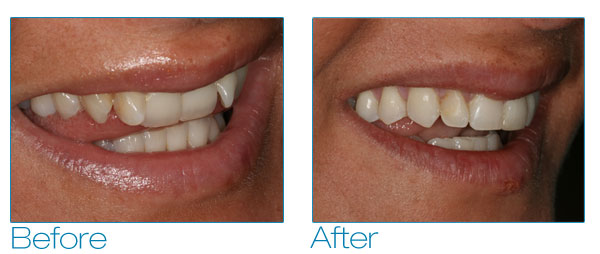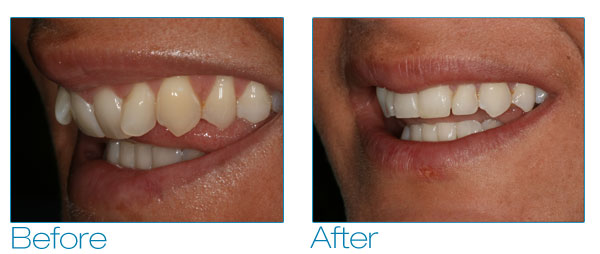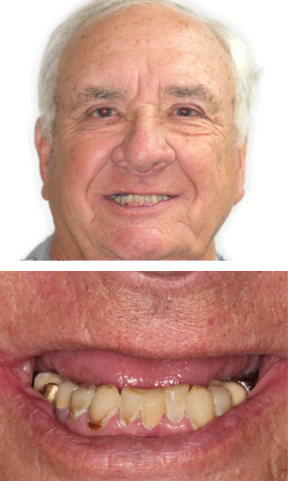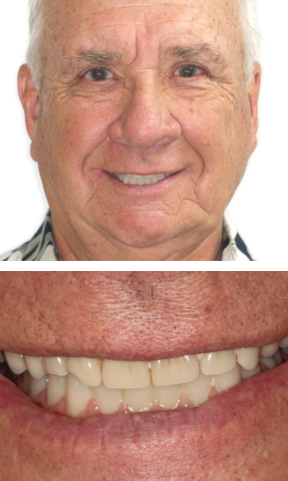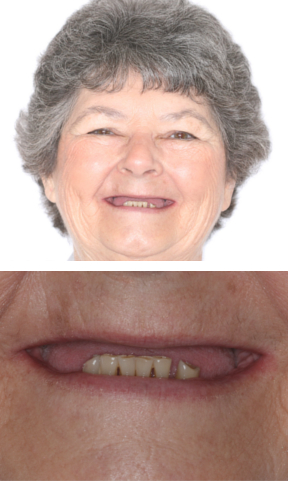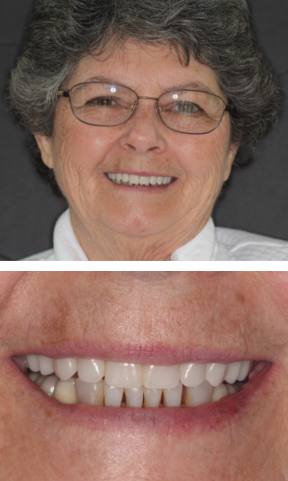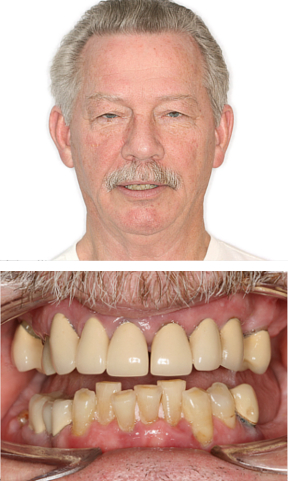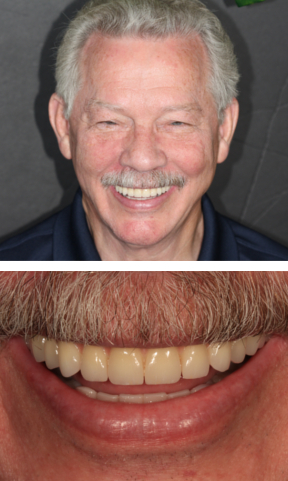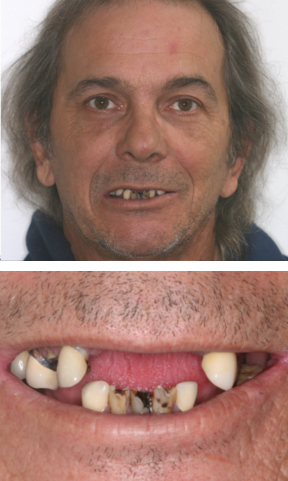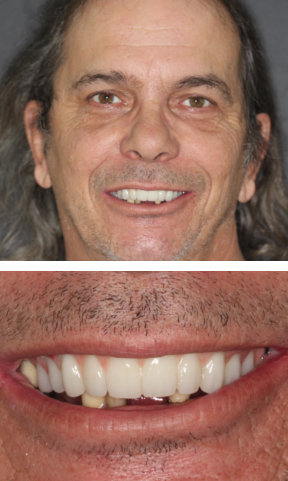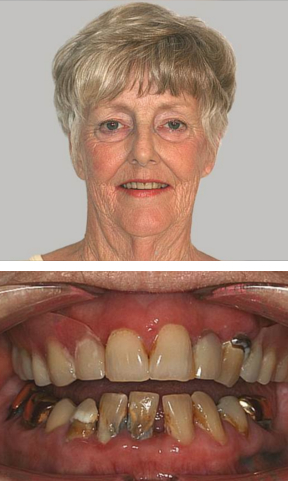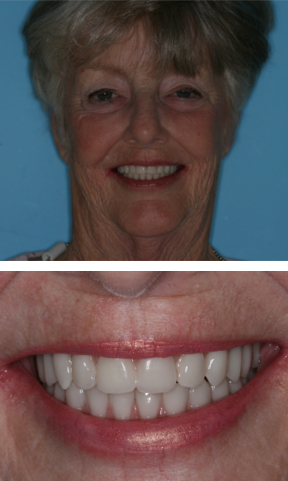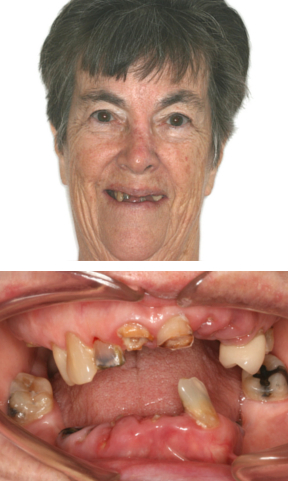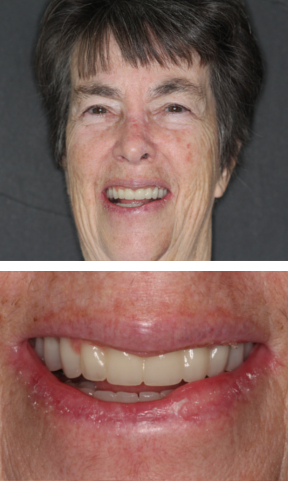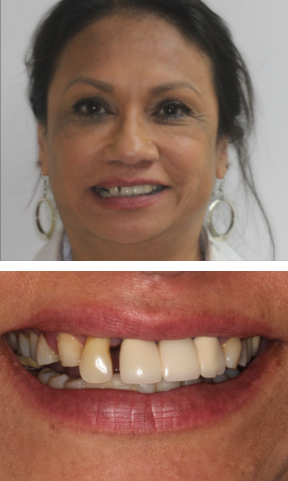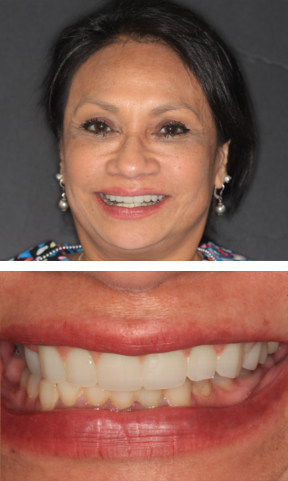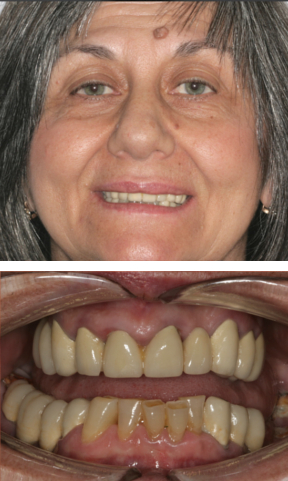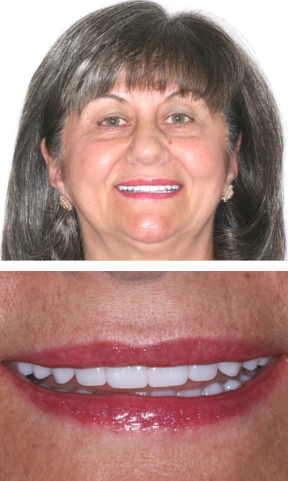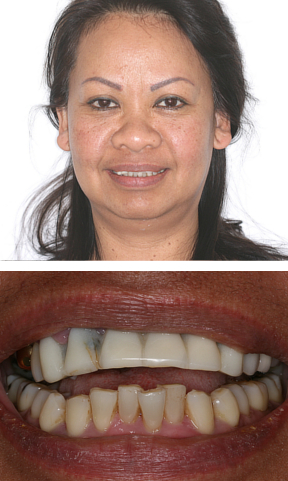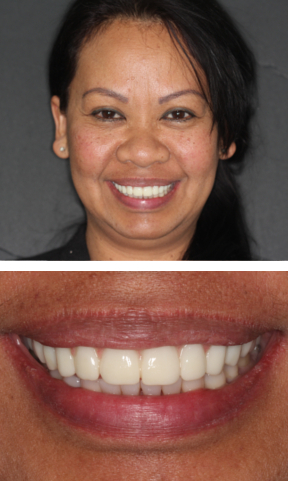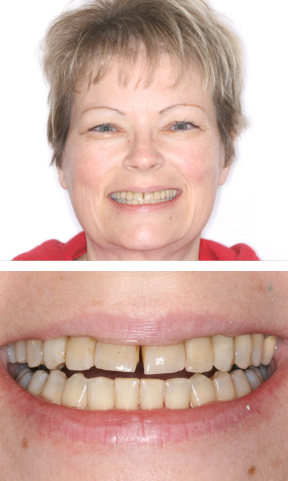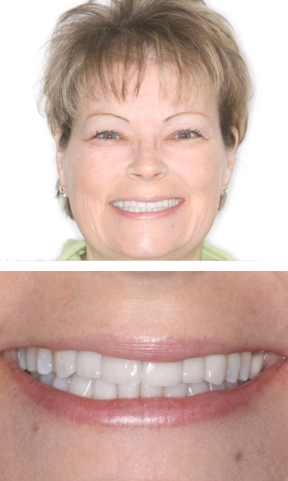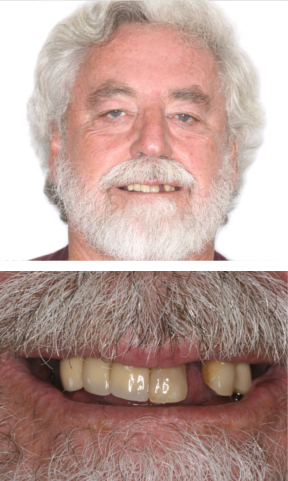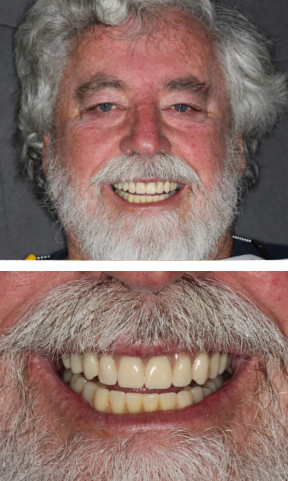Implants are a very good option for replacing a single tooth or many teeth. This gallery is designed to show you some of the uses of dental implants.
GuidedSMILE Teeth In A Day
Lower Implant Bridges – Upper Denture
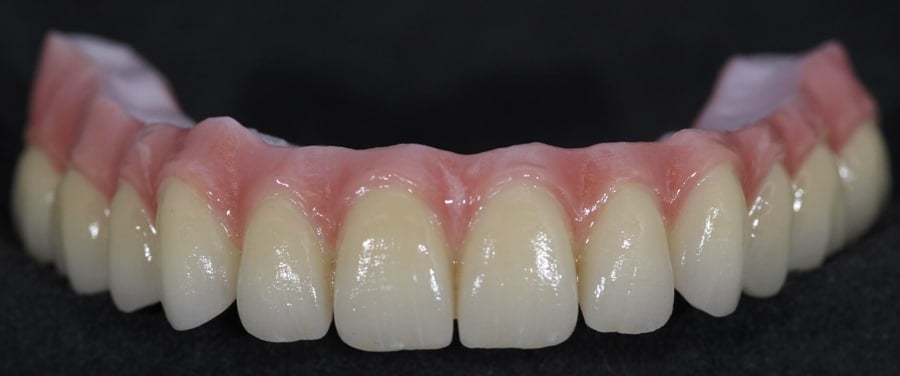
Implant with Non-Removable Zirconia Teeth
Upper Implant GuidedSMILE Teeth In A Day
Upper Removable Teeth with Lower Implant Non-Removable Teeth
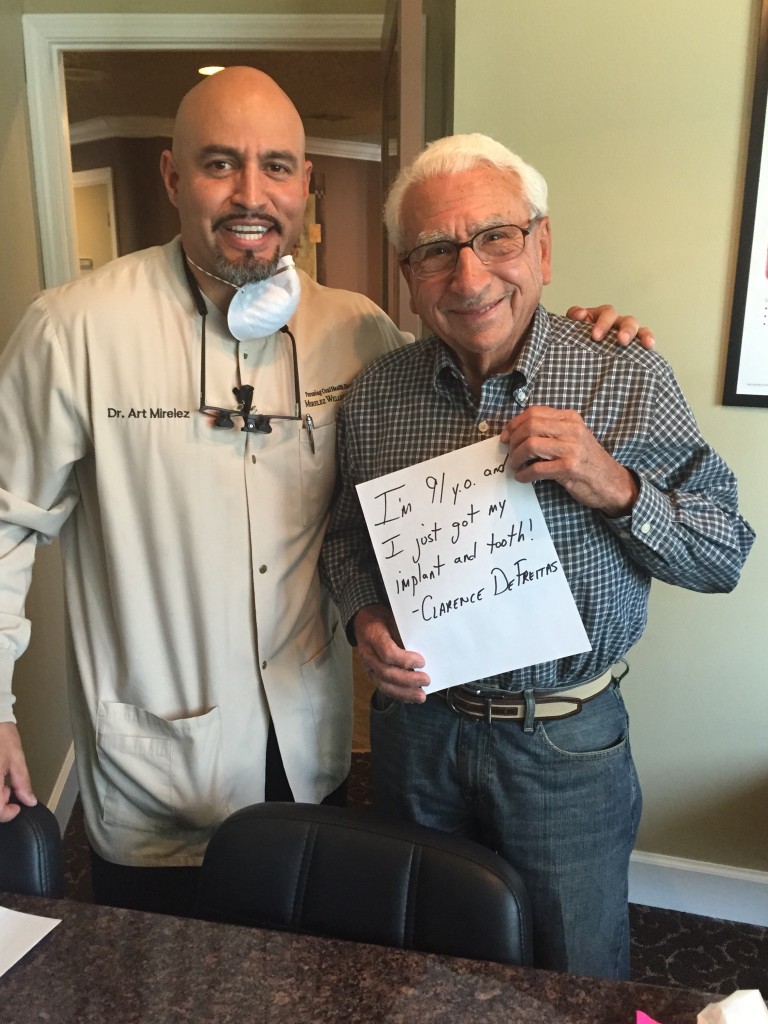
Oldest Implant Patient – 91 Years Old
Implant GuidedSMILE Teeth In A Day
Upper Implant GuidedSMILE Teeth In A Day
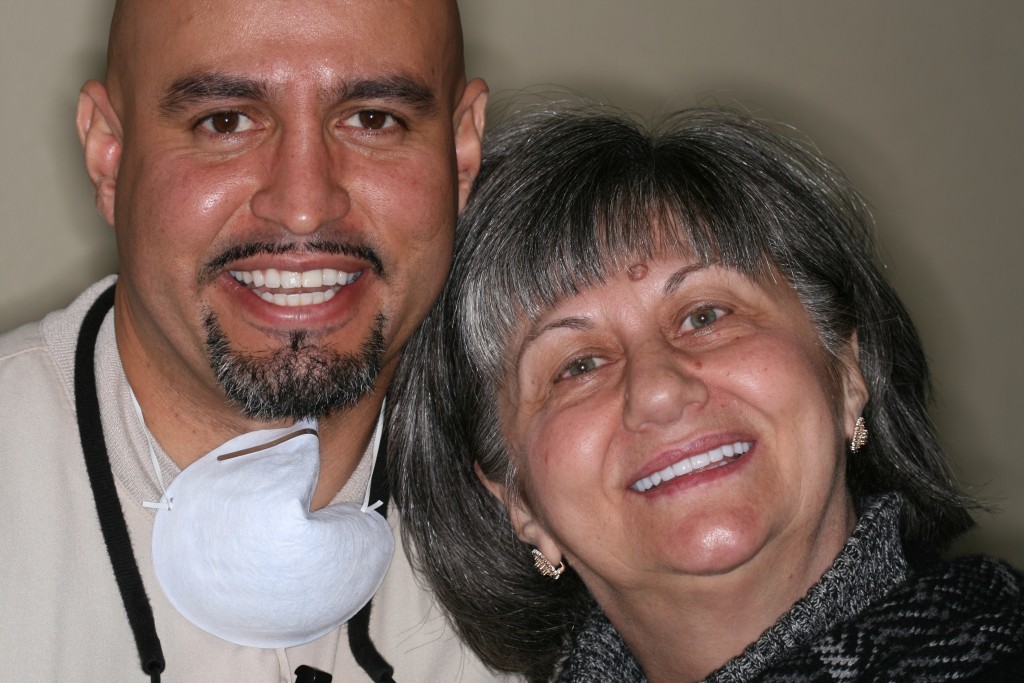
Implants with Non-Removable Teeth
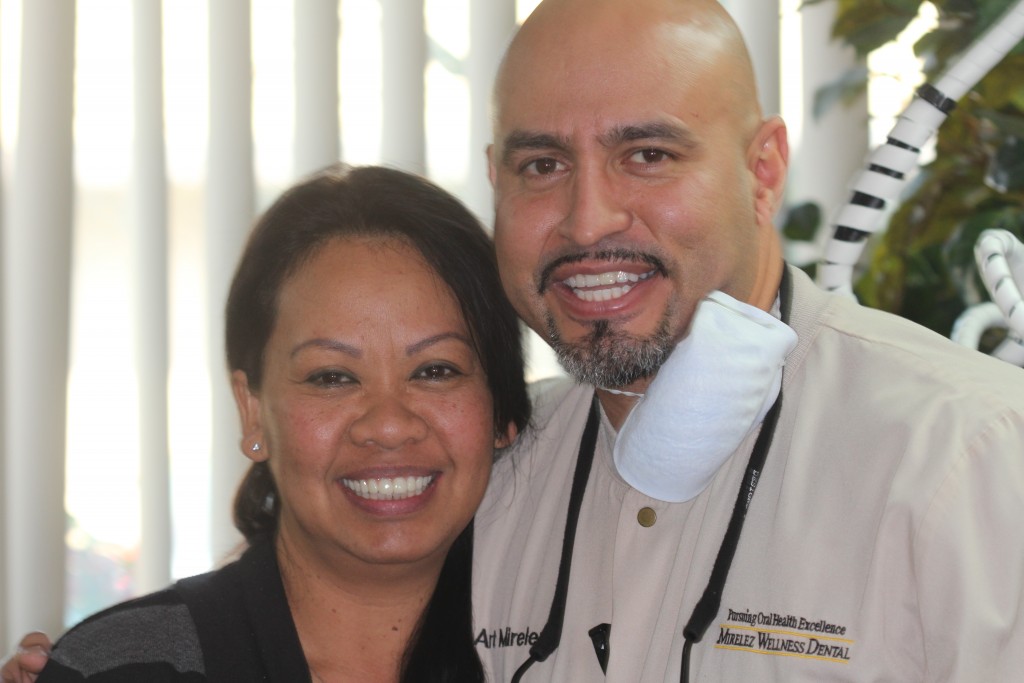
Upper Implant GuidedSMILE with Lower Bonding and Orthodontics
Upper Single Implants, Crowns and Orthodontics
Upper and Lower Implants with Snap On Teeth
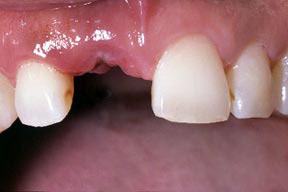
BEFORE | This patient lost her front tooth in an ice skating accident. The options were to place a three tooth bridge, which requires the removal of some of the adjacent teeth; an implant; or a removable appliance such as a partial denture. The patient chose to have an implant placed.
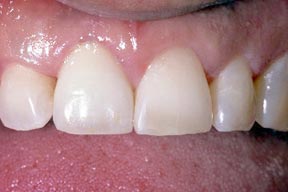
AFTER | The completed treatment appears completely natural. If you did not know that there had been a tooth missing, you would not be able to tell that any treatment had been done.
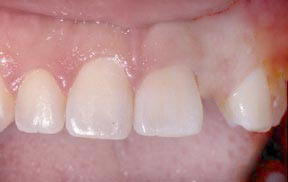
BEFORE | The most common of the congenitally missing teeth are the upper laterals. This patient was born without an adult lateral tooth.
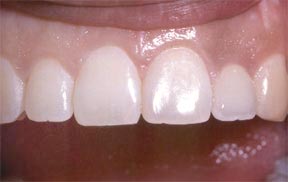
AFTER | A single implant was placed and the result is very natural looking. The center tooth, next to the implant, had a veneer placed on it, and the gum tissue was trimmed so that it matched the center tooth next to it.
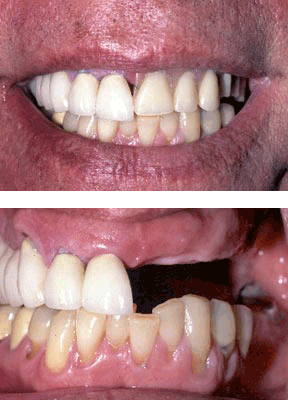
BEFORE | This patient lost several teeth in an auto accident. In the top photo, he is wearing a removable partial denture, which did not match his other teeth, which were had porcelain crowns.
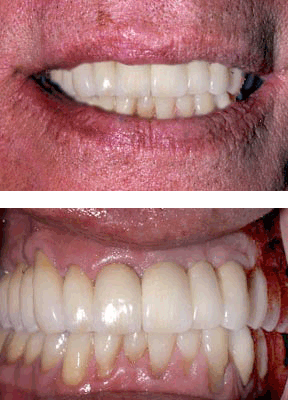
AFTER | Six implants were placed and the old crowns were replaced. The result is very natural looking and the patient now has the confidence to eat, laugh, and smile.
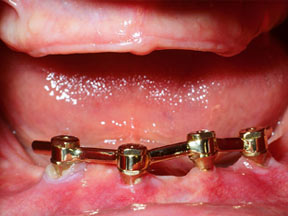
BEFORE | This patient lost all of his natural teeth many years ago and wore upper and lower full dentures, but had difficulty with his lower dentures staying in place. Implants were placed on the bottom. The patient had no problem with his top denture staying in place so no implants were placed on top.
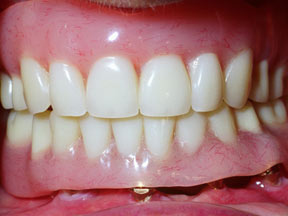
AFTER | The lower denture clips onto the bars between the implants and is very stable, yet the patient is able to remove the denture when he needs to brush and clean the implants. The result is a solid chewing surface and the patient can eat whatever food he desires.
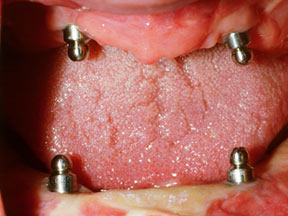
BEFORE | This patient had lost all of her natural teeth and had worn dentures for over 20 years. Both the top and bottom dentures were loose because there was not much bone for the denture to sit on. Four implants, two on top and two on the bottom, were placed.
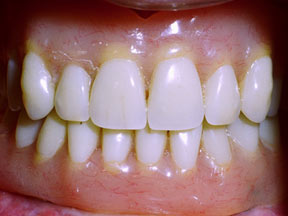
AFTER | The dentures are removable for cleaning, but they clip onto the implants using rings. They are very stable and natural looking.
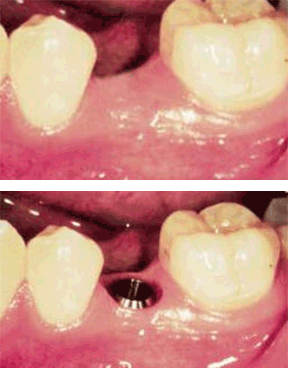
BEFORE | The picture on top shows the patient with a missing tooth. On the bottom, a dental implant has been placed and the gum tissue has healed for six weeks.
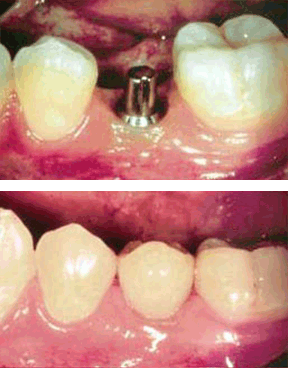
AFTER | The picture on top shows the implant with a post, which is the foundation for a porcelain crown. On the bottom is the finished treatment, which shows how natural dental implants can appear.
Bonding is a process used to restore chipped, discolored, and misshapen teeth in a single visit. The results are very natural in appearance, but bonding does take more maintenance than porcelain veneers and may not last as long. Less tooth structure needs to be removed, which makes bonding a more conservative choice for some cases.
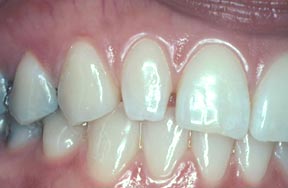
BEFORE | This tooth has a developmental defect, which is called a peg lateral. This only occurs in the lateral teeth, one tooth away from the centerline of the mouth on each side. There is nothing wrong with the tooth but the patient wanted to have it treated for cosmetic reasons.
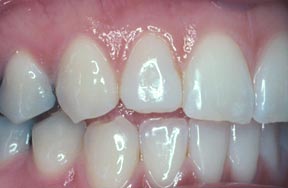
AFTER | The treatment consisted of shaping the tooth with a composite material to make it look more natural. This procedure took one appointment and was done without any anesthetic. Periodic polishing will help maintain the shine and luster of this restoration for many years.
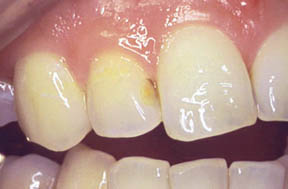
BEFORE | This is an old tooth-colored filling that has been in place for many years and needs to be replaced because of discoloration as well as wear. The wear may allow bacteria to enter and cause decay if the filling is not replaced.
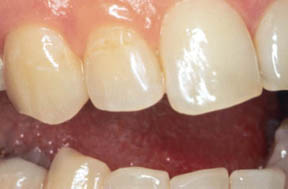
AFTER | The filling has been replaced with a newer tooth-colored filling that should last for many years. This restoration was completed in one office visit.
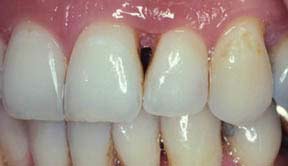
BEFORE | This patient was unhappy with the space between two of her teeth. This was the result of a periodontal (gum) defect between the teeth.
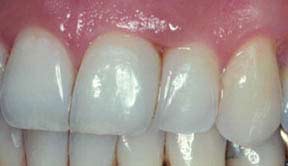
AFTER | Composite, which is a tooth-colored material, was bonded to both of the teeth. This procedure took one office visit. The result was a more aesthetically pleasing appearance and it gave the patient confidence to smile again.
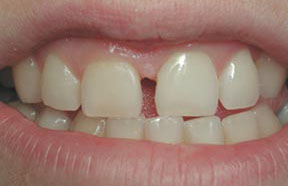
BEFORE | This patient was unhappy with two issues: the space between her upper front teeth and the different heights of the gum tissue above her teeth, which made the teeth appear to be of different lengths.
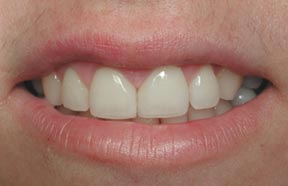
AFTER | Step one of her treatment was to even out the height of the gum tissue. After healing, which took several weeks, the space, which dentists call a diastema, was closed using composites bonded to her teeth. The total number of treatments was two; one for the gum tissue and one for the bonding and the result was exactly what the patient had in mind.
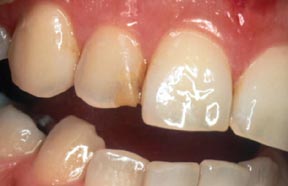
BEFORE | The lateral, or side tooth, had an old tooth-colored filling that was showing its age. Older composites were much more porous than the newer composites and, therefore, they show more discoloration over time.
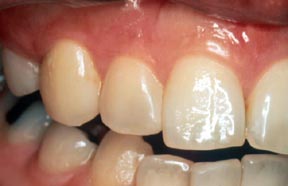
AFTER | In one office visit, the old filling was removed and replaced with new composite bonding material. The result is a much more natural appearance.
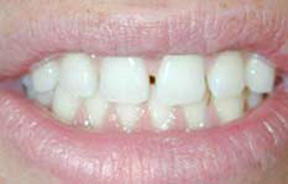
BEFORE | This patient did not like the natural gap between his two front teeth.
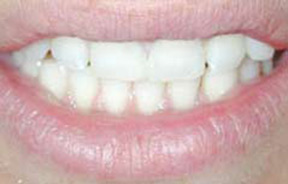
AFTER | Composite bonding was placed in one office visit. Bonding takes periodic touch-ups to keep it looking like new.
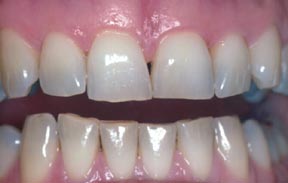
BEFORE | This patient was not happy with the color of her teeth. She also disliked the worn edges of her top teeth, related to her teeth-grinding habits.
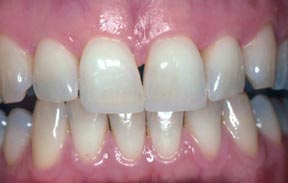
AFTER | First, the patient’s teeth were lightened with an at-home whitening process. When she was satisfied with the color, composite bonding was added to the edges to restore the natural tooth structure that was lost due to grinding.
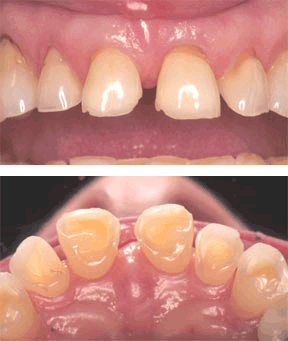
BEFORE | There are several issues with this patient’s teeth. He is a heavy grinder, which causes the edges of the teeth to chip away and the wear patterns in the lower image. The yellowish area is the second layer of tooth structure, which is the dentin. The dentin is much softer than the outer layer of tooth (enamel). If you look closely at the top image, you will also see that the teeth are starting to wear away at the gum line, which may be caused by grinding or by brushing too hard.
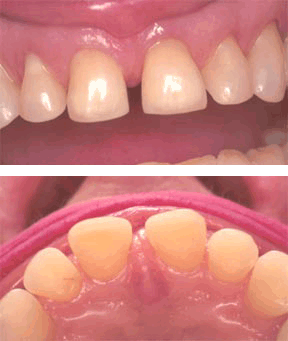
AFTER | The treatment consisted of composite bonding at the gum line, at the edges of the teeth, and on the inside, as well as making a nightguard to protect the composite and the tooth structure. The results were very good when compared to the before images. The patient did not want the space closed.
Crowns are placed when the entire structure of a tooth is compromised or when missing teeth are replaced with fixed bridgework. The cases in the Crowns Gallery are examples of treatment that can be provided using porcelain crowns.
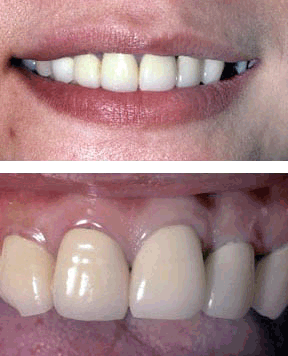
BEFORE | This patient had four porcelain crowns placed on her front four teeth from a previous dentist following a rollerblading accident. She was not happy with the color and she felt that they did not look very life-like. She had also chipped the tooth on the far left.
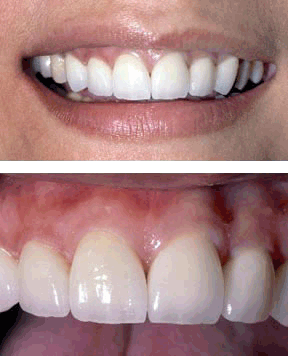
AFTER | The previous crowns were removed and after two appointments the new porcelain crowns were cemented. They now have the appearance of natural teeth and have a definite lifelike quality to them. The patient is very happy with the result.
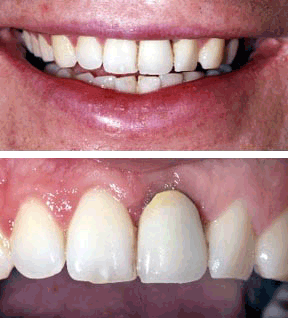
BEFORE | Most dentists would agree that the single hardest restoration to do is a single crown on a central incisor. The upper central incisors are the two front teeth in the middle of the upper jaw. It is a difficult process because the crown must match the remaining central incisor. This patient had a crown placed by a previous dentist. After a few years the gum tissue receded and exposed the margin.
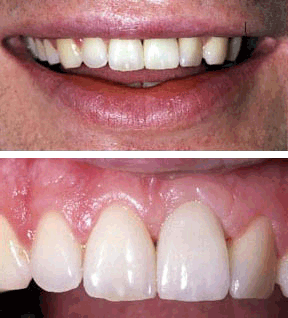
AFTER | The previous crown was removed, and after two appointments, the new porcelain crown was cemented. The new crown matches the adjacent central incisor and has the appearance of a natural tooth.
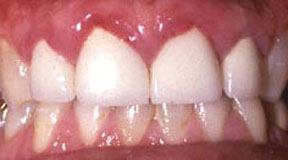
BEFORE | This patient had existing crowns on the front four teeth that were too white (yes, crowns can be too white!). They did not fit the teeth properly and caused the gums to swell and become red. The way in which crowns fit the teeth is as important as the way they look.
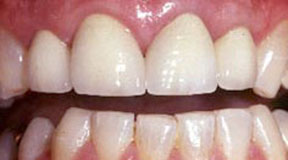
AFTER | The old crowns were replaced with new porcelain crowns. The new crowns appear more natural and fit the teeth properly; evident by the way the porcelain meets the gums.. In cases like these, the gum tissue takes a few weeks to heal.
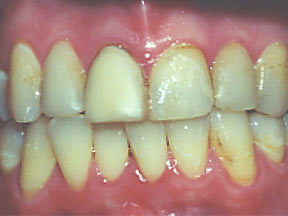
BEFORE | This patient had an existing crown on a central incisor and was unhappy with the unrealistic appearance. He was similarly unhappy with the shape, color, and appearance of his other, natural teeth.
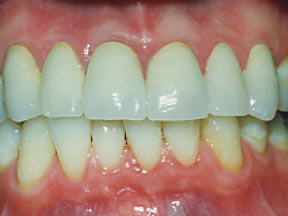
AFTER | The previous crown was removed. At his second appointment, the new porcelain crown and five porcelain veneers were cemented. The teeth are now in harmony and they look very natural. The lower teeth were cleaned and whitened before the top teeth were restored so that the the teeth are now in harmony and look very natural.
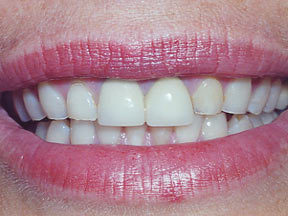
BEFORE | This is a combination case involving both crowns and veneers. There were old porcelain crowns on the two front teeth. The patient was unhappy with the color, shape, and length.
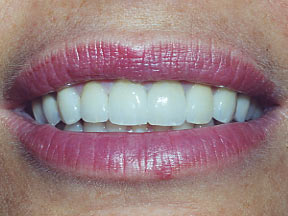
AFTER | The treatment involved the front six teeth. The old porcelain crowns on the two front teeth were replaced with new porcelain crowns. Four porcelain veneers were placed on the two teeth on either side of the front teeth. The result is natural-looking and aesthetically pleasing. The patient was very pleased and was no longer self-conscious about her smile.
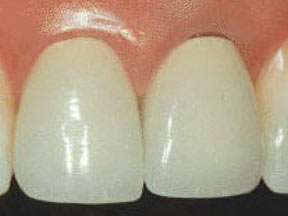
BEFORE | This is an extreme close up of two porcelain crowns that were placed by a previous dentist. The patient was unhappy because the crowns were not equal in size and a black edge was visible near the gumline of the crown on the right of the photograph.
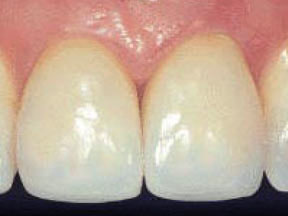
AFTER | Two new porcelain crowns were made and placed with a much better result. They look more natural and life-like than the previous crowns.
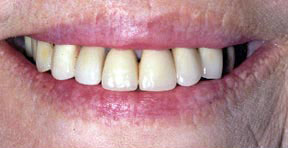
BEFORE | This patient had crowns and bridges on several teeth that were decayed. This necessitated replacement of the existing work. Her wish list was to improve the aesthetics and the angulation.
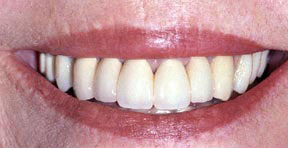
AFTER | The results rejuvenated the patient. In her words, “All I have to do is open my mouth and my teeth are smiling!”
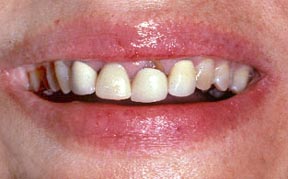
BEFORE | This patient had crowns and large fillings on almost all of her top teeth. She was so unhappy with her current appearance that when asked to smile she said, “I don’t have one.”
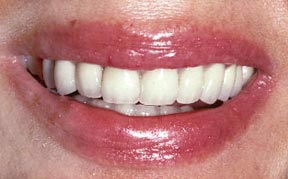
AFTER | Treatment involved placing ten porcelain crowns. The results are evident in the expression on her lips. The word “smile” was back in her vocabulary.
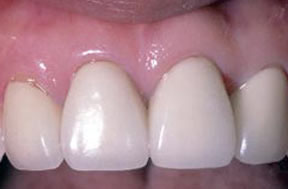
BEFORE | This is another close up of the front four teeth. The gum tissue is healthy but the patient wanted more natural-looking crowns to replace the old crowns, which were starting to show darkness at the gumline and appeared dull.
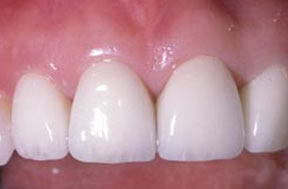
AFTER | The four crowns were replaced with four porcelain crowns that met the patient’s desire for them to look like natural teeth.
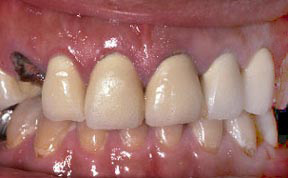
BEFORE | This patient’s tooth broke off at the gumline. He also had crowns on some teeth that did not fit well and needed to be replaced.
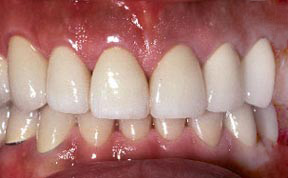
AFTER | The patient was very happy with the results. An implant replaced the broken tooth, the old crowns were replaced, and the bottom teeth were whitened.
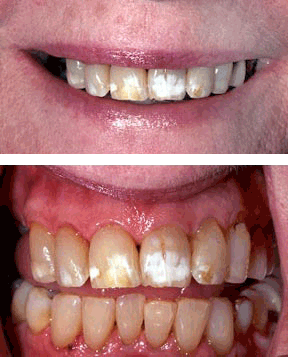
BEFORE | As evident in the lower image, the patient was missing the upper back teeth on one side (left side of the photo). She was unhappy with the missing teeth and the appearance of the rest of her teeth.
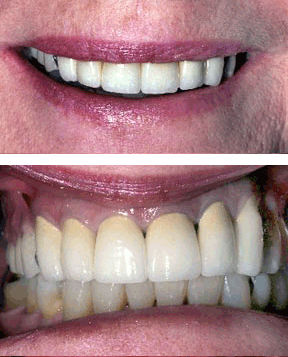
AFTER | The results were achieved with implants to replace the missing teeth and crowns and veneers to improve the aesthetics of her natural teeth.
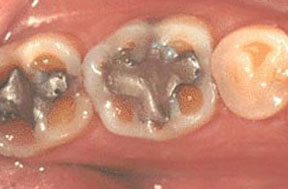
BEFORE | This is an image of the last three teeth in the lower jaw. They had very old silver fillings. The fillings and the teeth were wearing out.
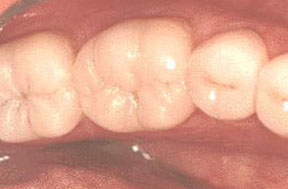
AFTER | The treatment consisted of placing porcelain crowns on the teeth. These crowns are more than just for appearance. They returned the teeth to their original height and shape; restoring function.
This section of the gallery displays cases in which some or all of the patient’s teeth were missing. In these cases, traditional removable full or partial dentures were used to restore form and function to the patient.
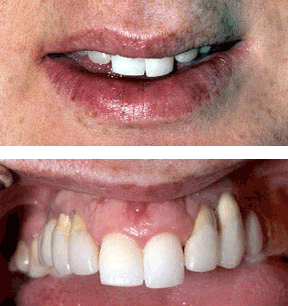
BEFORE | This patient had severe gum and bone problems, which required the removal of all of the upper teeth except for the two front teeth.
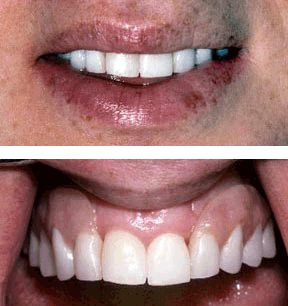
AFTER | A removable partial denture was made that closely matched the remaining front teeth. The result a significant improvement in his appearance.
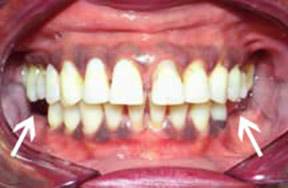
BEFORE | This patient was missing the bottom molars on both sides of his mouth, as indicated by the white arrows.
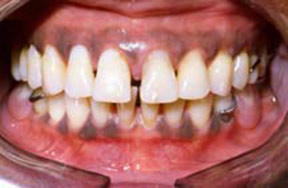
AFTER | A removable partial denture was made to restore lost chewing surfaces.
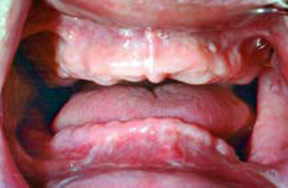
BEFORE | This patient is missing all of his teeth. A traditional full denture is needed.
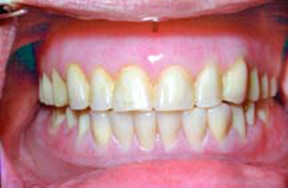
AFTER | Dentures are made more realistic by making them slightly less than perfect.
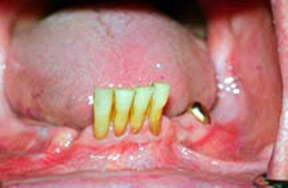
BEFORE | This patient lost all of her teeth with the exceptions of the front four teeth on the bottom and a portion of a tooth, which has a gold crown on top of the root (bottom right of the photo). It is important to save the root of a tooth because it helps preserve the bone, which is critical.
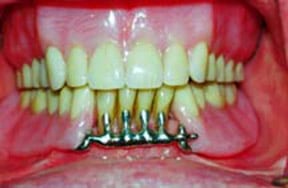
AFTER | The metal holding the partial denture in place is not visible when the patient speaks or smiles.
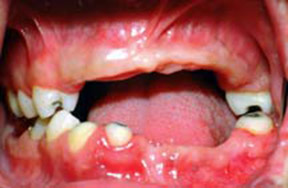
BEFORE | This patient had a developmental defect that caused a malformation of the jaws as well as the teeth.
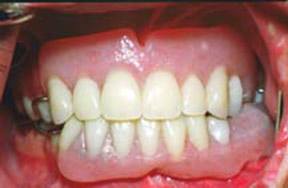
AFTER | A removable partial denture was made for both the top and bottom to replace the missing teeth and to restore the aesthetics.
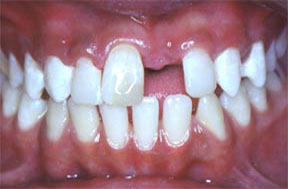
BEFORE | This patient lost his front tooth in a skateboarding accident. The left front tooth was badly chipped and was repaired with tooth-colored bonding, but the root on the right front tooth was split in two and could not be saved.
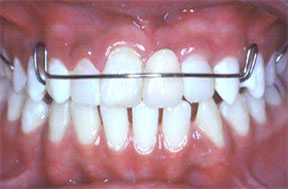
AFTER | We made a temporary retainer with a tooth attached to the wire until the bone healed. After the bone healed, an implant could be placed.
A filling replaces a portion of a tooth due to decay or breakage. Fillings may take one or two appointments. A filling that is made in your mouth takes one appointment and one that is made out of your mouth typically takes two appointments.
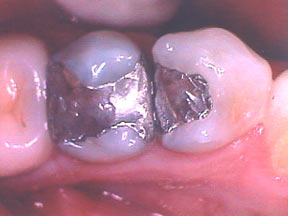
BEFORE | These are two old silver fillings that have served the patient well for many years. They are starting to show their age and need to be replaced.

AFTER | he left tooth was restored with a porcelain onlay, which covers the entire chewing surface of the tooth. The right tooth was restored with a porcelain inlay, which covers only the necessary part of the chewing surface.
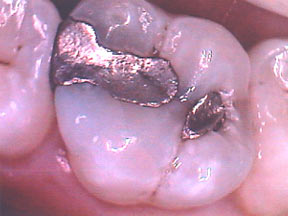
BEFORE | This is a back molar with two separate silver fillings that are very old. They need to be replaced.
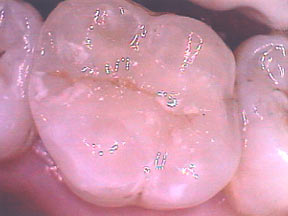
AFTER | The tooth was restored with a porcelain inlay, which leaves the cusps of the natural teeth exposed.
]
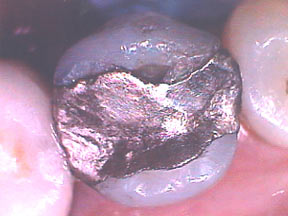
BEFORE | This is another silver filling that is showing its age and needs to be replaced.
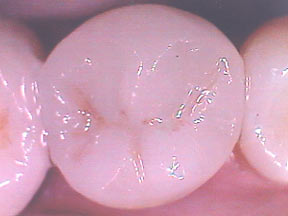
AFTER | The tooth was restored with a porcelain onlay since the cusps, which are the tips of the teeth, were too weak to be restored without being covered.
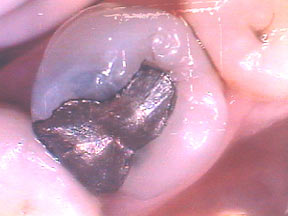
BEFORE | This is a silver filling that had decay near the gumline and needed to be replaced.
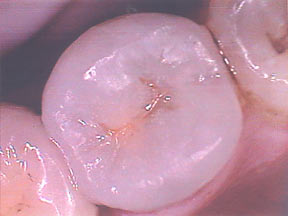
AFTER | The filling was removed and replaced with a porcelain inlay. The majority of the tooth was healthy and did not need to be restored.
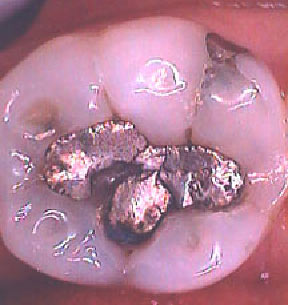
BEFORE | This is a lower molar with a fractured silver filling on the chewing surface and a separate silver filling on the outside portion of the tooth.
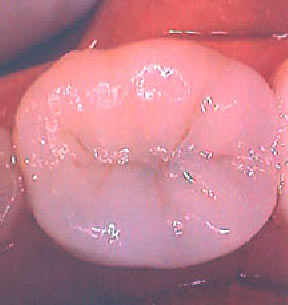
AFTER | The extent of the decay indicated replacement of the entire chewing surface, so a porcelain onlay was used.
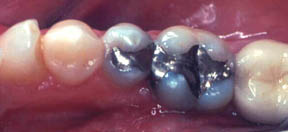
BEFORE | These two teeth had old silver fillings that needed to be replaced.
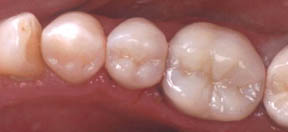
AFTER | The smaller tooth was restored with a porcelain inlay and the larger tooth was restored with a porcelain onlay.
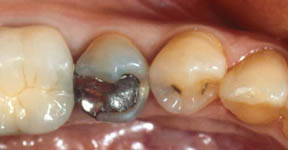
BEFORE | This tooth has a large silver filling that is several years old and needs to be replaced.
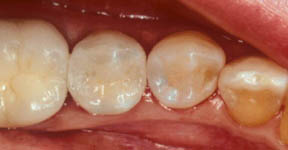
AFTER | A porcelain inlay was used, which restored the natural beauty of the tooth.
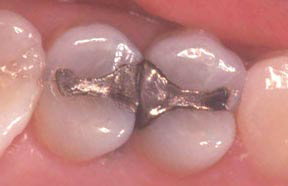
BEFORE | The silver filling on the left had decay underneath it that was detected with an x-ray during a routine check-up.
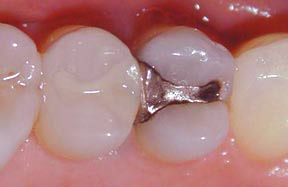
AFTER | The silver filling was removed and it was replaced with a tooth colored composite filling that took a single appointment.
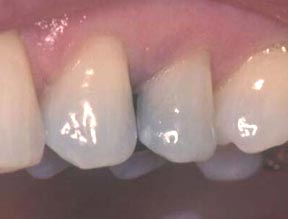
BEFORE | The tooth in the middle of the image had a silver filling that needed to be replaced due to new decay at the gumline.
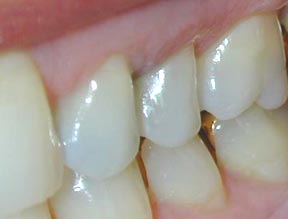
AFTER | The tooth was restored in one appointment with a composite filling.
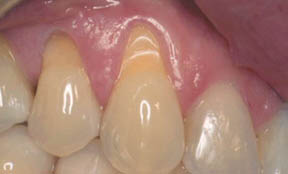
BEFORE | Both of these teeth had been brushed too hard with a hard-bristled toothbrush, which caused the gum to recede and the root surface to be scrubbed away.
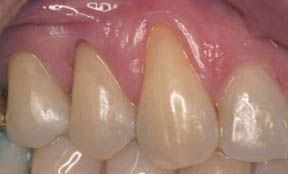
AFTER | Both teeth were restored with composite bonding, which replaced the missing root structure and provided protection to the remaining root surface.
The goal of any orthodontic procedure is to align the teeth to ensure proper function and proper aesthetics. Please browse through our orthodontics gallery to see the types of results that can be achieved with orthodontic treatment. The average treatment time for orthodontics is between eighteen to twenty-four months. However, the length of treatment will depend on the severity of the pre-existing condition, the type of treatment (removable appliances usually takes longer than fixed appliances) and the cooperation of the patient. At the completion of the active part of orthodontic treatment, the braces are removed and retainers are made to keep the teeth stable in their new position. These appliances may be removable retainers or fixed wires that are placed behind the teeth. Retainers play an important role in orthodontic treatment since teeth tend to rotate and move toward their original position.
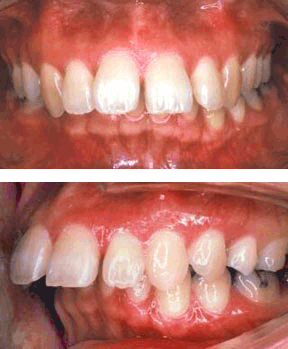
BEFORE | This case involved the front top teeth overlapping the front lower teeth too much, which caused the front lip to protrude. This is evident in the top photo, in which you can barely see the lower teeth. In the lower photo, you can see how the angulation of the front teeth is excessive.
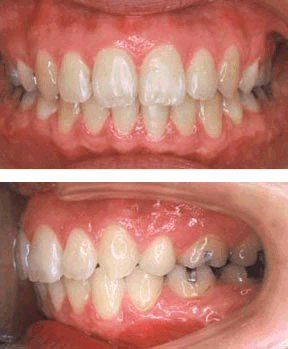
AFTER | After about 18 months of treatment, the top teeth have been moved back and up. In the top photo, you can see more of the bottom teeth and the alignment of the teeth looks appropriate. In the bottom photo, you can see that the angulation issue has been resolved. The result was a confident and happy patient.
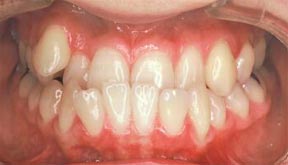
BEFORE | In this case, the front four top teeth are in a crossbite, meaning they appear behind the front four bottom teeth. The other issue is that the position of the cuspid, or canine tooth, needs correction.
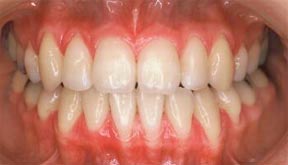
AFTER | Through the use of fixed appliances and 24 months of braces, all of the issues were corrected. The front four top teeth now appear in front of the front four bottom teeth and the cuspid has been brought back into proper alignment and it is now a functional tooth.
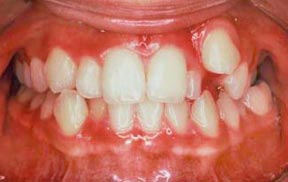
BEFORE | In this case, the cuspid on the right side of the photograph is sticking out and the tooth next to it is behind the front tooth. The bottom teeth are also out of alignment.
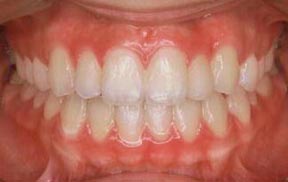
AFTER | Fixed braces were placed and results were achieved in 18 months. All of the teeth are now in proper alignment and are fully functional.
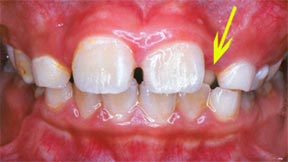
BEFORE | The yellow arrow is pointing to a lateral tooth, which is in crossbite. Crossbite means it is behind the bottom tooth, rather than in front of it.
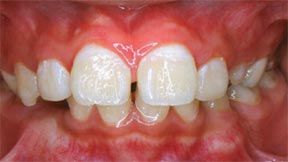
AFTER | These results were achieved in 12 months through the use of fixed braces. You can now see the tooth that was almost entirely hidden.
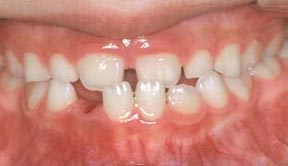
BEFORE | This is an example of a crossbite in a child. The two center teeth on top should be in front of the two center teeth on the bottom, but in this case they are behind them.
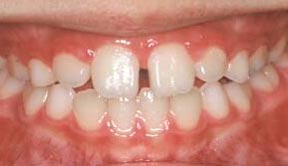
AFTER | Fixed braces were applied and the crossbite was corrected in 6 months.
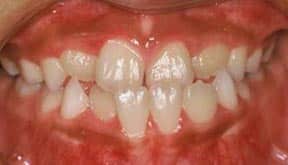
BEFORE | This is a crossbite involving the front four top teeth, which are misaligned behind the front bottom teeth.
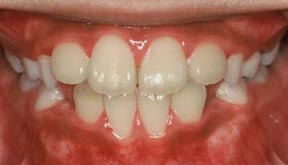
AFTER | This issue was corrected with fixed braces. The treatment time was 8 months and the teeth on top are now in front of the teeth on the bottom.
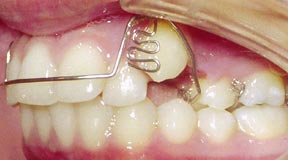
BEFORE | This cuspid, or canine tooth, did not erupt into proper position.
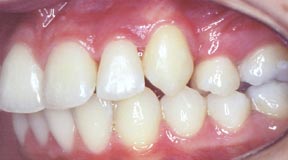
AFTER | A removable appliance was made to guide the tooth into its proper position.
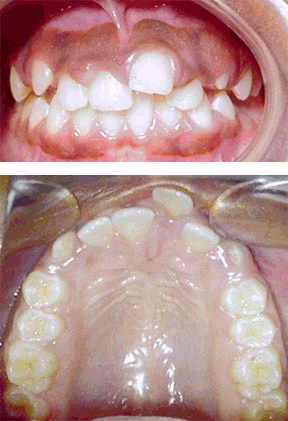
BEFORE | In this patient, the front right center tooth erupted too far forward. When this occurs, other teeth tend to shift into the space and cause problems.
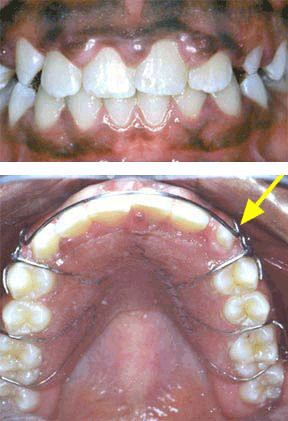
AFTER | Space was created using a fixed appliance for the tooth, and the alignment is being maintained by a removable retainer until the last adult tooth, indicated by the yellow arrow, fully erupts into place.
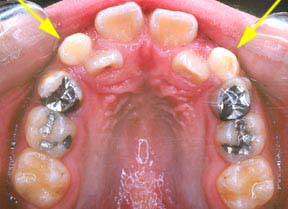
BEFORE | This is a good example of teeth erupting behind other teeth. The yellow arrows indicate the retained baby cuspid teeth, which will be removed to make room for the lateral teeth, which will be pushed forward.
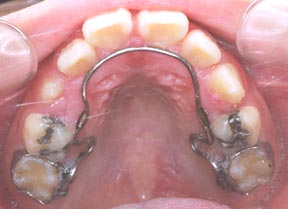
AFTER | After 8 months of treatment, the laterals are now in the correct position. They are being retained by a fixed retainer, which will be removed after all of the adult teeth have erupted into place. The two teeth with silver fillings are still baby teeth.
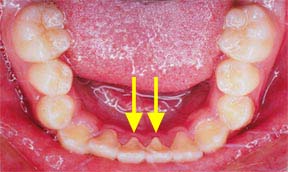
BEFORE | This patient’s lower teeth were slightly out of alignment. This is easily treated with a hidden retainer, meaning a retainer that is fixed to the inside of the teeth. Oral hygiene is very important at all times. The yellow arrows indicate the presence of tartar, and the gum tissue is red and irritated as a result.
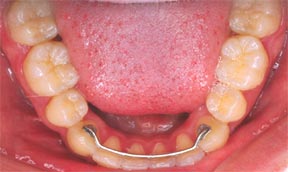
AFTER | The alignment of the teeth is corrected with the the fixed retainer. The health of the gum tissue is greatly improved.
Our periodontal gallery contains images of the types of cases that might necessitate periodontal treatment. The purpose of this gallery is to display the types of results that can be achieved through periodontal surgery.
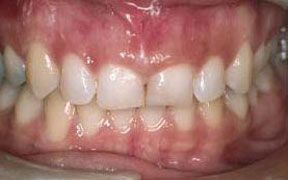
BEFORE | This patient was unhappy with her gummy smile. The gum tissues covered up too much of the teeth, making the teeth look too short.
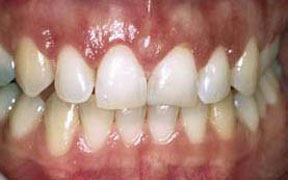
AFTER | A crown lengthening procedure was performed, which evened the height of the gum tissue across the front teeth. The result was dramatic and the patient was quite pleased.
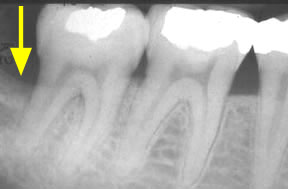
BEFORE | The yellow arrow above is pointing to an area where this patient has suffered some bone loss. The dark area indicates that the bone is not as dense and without treatment the prognosis for this tooth would be poor.
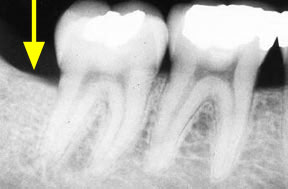
AFTER | A bone graft procedure was performed and the yellow arrow above is pointing to the regenerated bone. This area is much denser with bone than the same area in the image to the left. The prognosis for this tooth is now excellent.
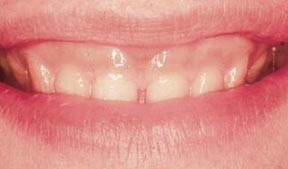
BEFORE | This is another case of a gummy smile. The gum tissue covered up too much of the teeth, which caused them to look short.
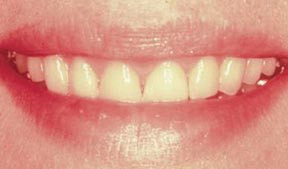
AFTER | A crown lengthening procedure was performed, which evened the height of the gum tissue across the front teeth. This type of procedure typically leads to patients smiling with more confidence…and much more often!
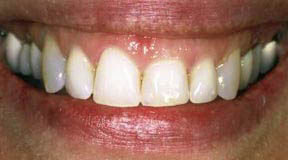
BEFORE | What is unusual about this case is the unevenness of the tissue height in the two front teeth.
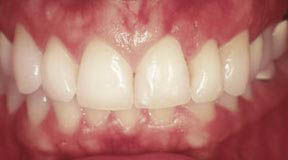
AFTER | A crown lengthening procedure was performed to make the height of the tissue consistent on both sides of the upper teeth.
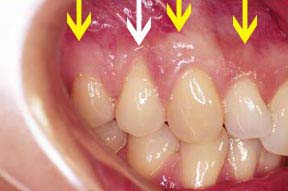
BEFORE | This patient is missing a lot of gum tissue around the neck of the tooth with the white arrow. In this case, it is necessary to do a gingival graft, which requires taking tissue from a site right next to the area missing the tissue or from the roof of the mouth, which contains plenty of healthy tissue. The yellow arrows are pointing to the line of healthy attached tissue, which is needed for the ongoing health of the teeth and underlying bone. You can see how much space there is between the yellow arrows and the neck of the tooth and how little space there is between the white arrow and the neck of the tooth.
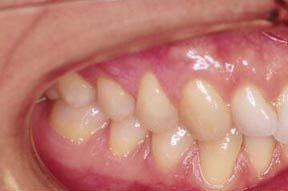
AFTER | This is the result of a gingival graft, which shows the presence of pink and healthy attached gingival tissue around the neck of the tooth. The prognosis for this tooth is excellent and the procedure took one appointment.
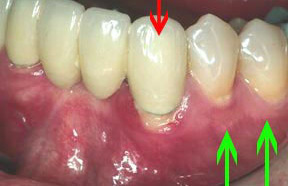
BEFORE | The tissue at the gumline of the tooth with the red arrow is not only very red but it is missing what is called the “attached tissue.” Without this tissue, bone loss is likely to occur. This patient does have attached tissue on the other teeth, from the neck of the tooth to the line that the green arrows indicating.
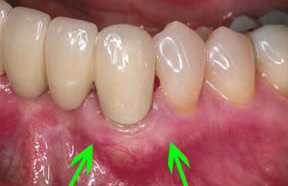
AFTER | Tissue was taken from the roof of the patient’s mouth and grafted to the area shown by the green arrows. Compare the image to the right with the image above. The tissue is much pinker and, therefore, healthier in the above image. The treatment, which took one appointment, should mean that this tooth will be of service to this patient for many more years to come.
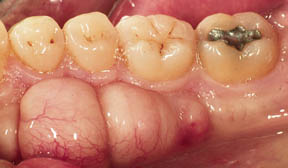
BEFORE | The large mass that you see above is simply an overgrowth of bone. It occurs in about 20% of the population. It only needs to be removed for cosmetic reasons, if it interferes with speech, or if a removal appliance such as a denture needs to be made.
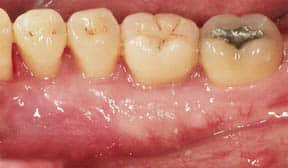
AFTER | This was a one appointment procedure, which was performed because the large overgrowth of bone was affecting speech and eating.
If the nerve of a tooth gets infected, it can be extremely painful. The goal of root canal treatment is to relieve pain, and restore your smile!
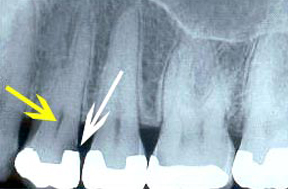
BEFORE | A root canal procedure involves removing diseased tissues (indicated by the yellow arrow), which contain the nerve and blood supply of a tooth, and replacing it with a rubber-type material. The area that is filled is called the “root canal.” The root canal of each tooth is very different. The reason this tooth needed a root canal was due to decay (indicated by the white arrow) entering the pulp.
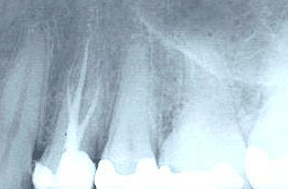
AFTER | This is what the completed root canal looks like on an x-ray. This tooth had three canals, which you can see by the white filling material in the root portion of the tooth.
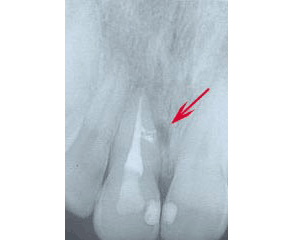
BEFORE | This tooth has what is called an “accessory canal,” which is a canal that splinters off in an unexpected direction. This tooth had to be retreated due to the first root canal failing, which is evident by the dark area, which is where the arrow is pointing. Upon retreatment, the accessory canal was found and filled, and the prognosis for this tooth is good.
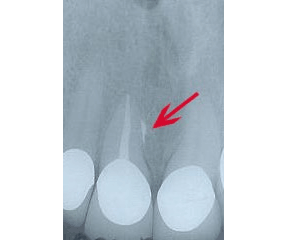
AFTER | This is a different tooth that also had an accessory canal, in the area indicated by the red arrow. The prognosis for this tooth is also good, but as with most root canals, a periodic exam and x-ray are needed to monitor for any issues.
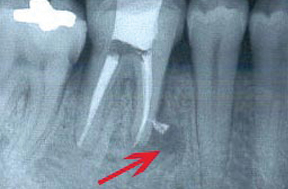
BEFORE | This is an example of a back tooth that developed a cyst (the dark area around the tip of the root). A root canal was performed and you can see some of the root canal filling material in the dark area, which represents an accessory canal. The prognosis for this tooth is good because the accessory canal was found and filled.
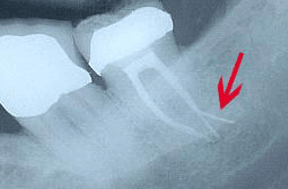
AFTER | This is another example of an accessory canal in a back tooth. This canal,by the red arrow, was rather large. The prognosis for this tooth is also good because the accessory canal was found and filled.
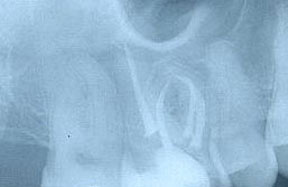
BEFORE | This is an x-ray of an upper molar with four canals, which is not very common. What makes the treatment of this tooth more difficult is the curvy nature of its canals.
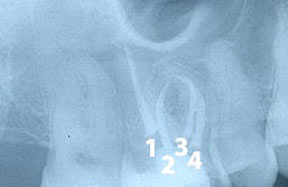
AFTER | The four canals have been labeled on this x-ray. Canal #1 is very straight but the other three canals, especially #3, are curved. Each canal must be free of any nerve or blood tissue before it is filled to ensure a good prognosis.
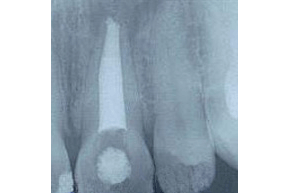
BEFORE | Most of the canals, where the nerve and blood vessels of the tooth reside, are narrow like the wick of a candle. Some canals are very wide, similar to this x-ray of a front tooth. This means there is less tooth structure surrounding the canal, which can indicate that the tooth is weaker.
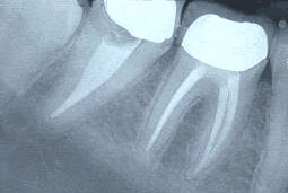
AFTER | The tooth on the right is what we typically expect to see in regard to a normal root canal anatomy. This tooth has three separate canals. The tooth on the left has only a single canal, which is why the filling material appears so wide. The internal anatomy of each tooth is different, which makes each root canal procedure unique.
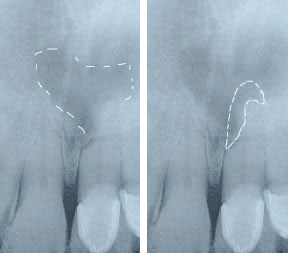
BEFORE | This is an x-ray of an upper front tooth. The root on this tooth is shorter than normal. The cells of the root of the tooth are being eaten away in a process that is called external resorption. This process usually occurs very slowly over a several months or years and is usually associated with some sort of trauma to the tooth. The dotted line on the left image above indicates an infection from the left tooth. The dotted line on the right image above represents that portion of the root of the tooth that has been lost due to the resorption.
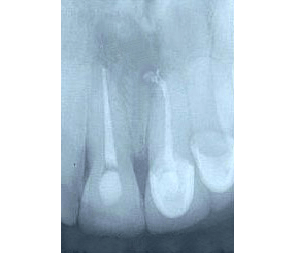
AFTER | The treatment is a conventional root canal procedure, which may take one or two visits. This procedure is a last attempt at saving the tooth. The success of this procedure depends upon when the resorption is diagnosed and treated, the length of the root of the tooth, and the health of the surrounding bone. An annual exam with x-rays is the only way to monitor the prognosis of the tooth. In the case above, both teeth showed signs of resorption, which is why they were each treated with a root canal.
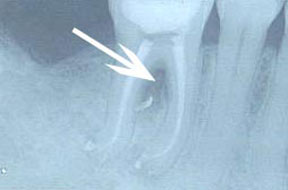
BEFORE | This is an x-ray of a back tooth, known as a molar, which was taken immediately after root canal treatment. The arrow is pointing to a dark area, where there is an infection.
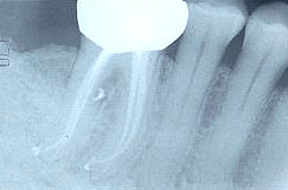
AFTER | This x-ray was taken approximately one year after the root canal treatment. Notice that the dark area has filled in with bone, indicating that the root canal was successful. The large white area on the top portion of the tooth is a crown, which is required treatment for almost all back teeth that have a root canal.
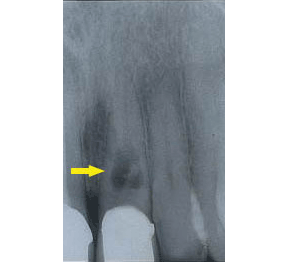
BEFORE | The yellow arrow above indicates internal resorption. This occurs when the cells inside the tooth destroy the root from the inside out. This process usually happens very slowly over a matter of months or years and is usually associated with some sort of trauma to the tooth.
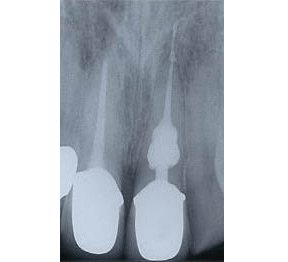
AFTER | The treatment for internal resorption usually takes a two or more appointments. First, a medicated filling is placed and then, after a few weeks, the medicated filling is removed and the procedure is completed in the conventional way. This type of condition requires annual examination by x-ray to check on the tooth. The prognosis is fair to poor, but the only other option is to extract the tooth.
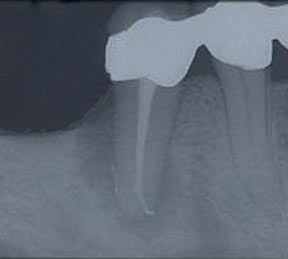
BEFORE | The dark area around the entire root of the tooth above indicates the presence of a large infection.
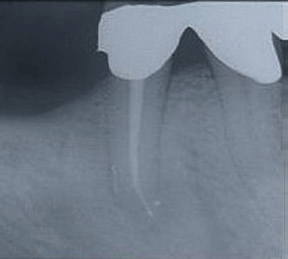
AFTER | Conventional root canal treatment was performed and this is an x-ray of the tooth about six months later. You can see the dark infected area has disappeared and has been replaced by healthy bone structure. The prognosis for this tooth is excellent.
Porcelain veneers are made from a ceramic material that is bonded to the front of teeth to change the tooth’s color, size, and/or shape. These must be made outside of the mouth and they require more than one visit. The natural results we can achieve with porcelain veneers are incredible. Please look though our Veneers Gallery to see some examples of the type of dentistry that we provide for our patients.
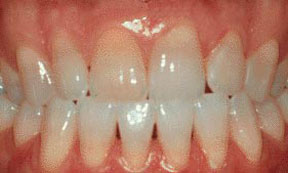
BEFORE | This patient was not happy with many things. One of her front teeth was discolored, and she did not like the spaces or the length of her teeth.
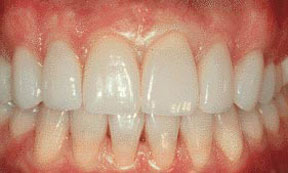
AFTER | This is the result of her treatment after the placement of eight porcelain veneers. The color is very natural, the spaces have been closed, and the teeth have been lengthened.
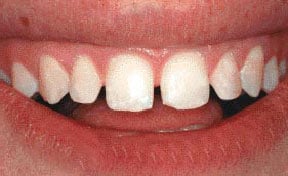
BEFORE | The main complaint this patient had was spacing, but he also wanted his chipped teeth fixed as part of the treatment plan.
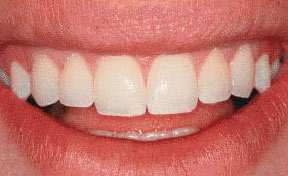
AFTER | This is the result after the placement of six porcelain veneers, which made the patient very happy. The spaces have all disappeared and his teeth look very natural, giving him a tremendous confidence boost.
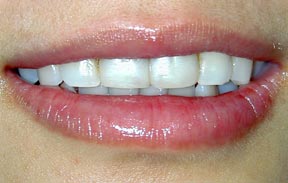
BEFORE | This patient had her front teeth bonded several years ago and the bonding was beginning to show its age by having lost some of its luster.
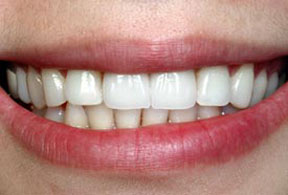
AFTER | The treatment was to remove the old bonding and replace them with porcelain veneers. The result is a very natural, life-like appearance and the patient was very happy!
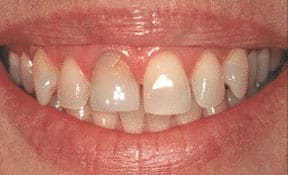
BEFORE | This patient did not like the color, shape, or spacing of her teeth. She was very self conscious of her smile.
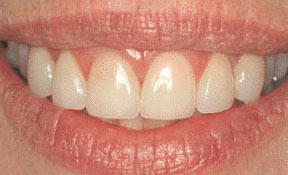
AFTER | After placement of six porcelain veneers, all of the patient’s goals were met and she was very happy with the result.
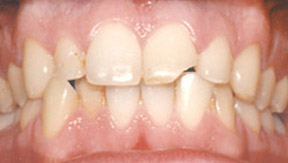
BEFORE | This patient broke his tooth when he accidentally bit into a fork while eating.
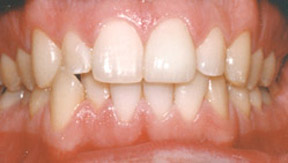
AFTER | A porcelain veneer was placed and the result appears as if the tooth was never broken!
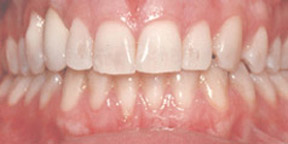
BEFORE | This patient was not happy with the different lengths of her two front teeth, the basic shape of all of her front teeth, as well as the color.
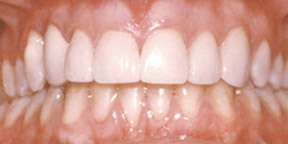
AFTER | Five porcelain veneers were placed and the patient was very happy with the results. The canine tooth in the upper left of the photo was an existing crown, which is why five veneers were placed instead of six.
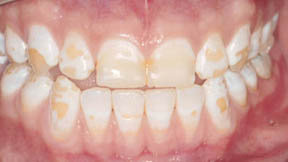
BEFORE | This patient has what we called “mottled” enamel, which can be caused by too much fluoride when the teeth are being formed.
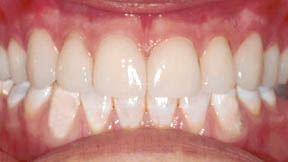
AFTER | Treatment consisted of placing ten porcelain veneers on the upper teeth, which resulted in a very natural appearance. Treatment required two appointments, a few days apart. The lower teeth were treated with composite bonding due to the patient’s financial constraints.
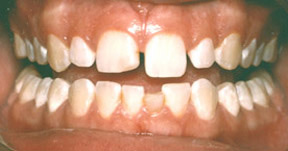
BEFORE | This patient was unhappy with several things. First, she did not like the space between her teeth and was dissatisfied with the uneven lengths and the alignment. If you look carefully at the bottom teeth, you will notice that one tooth is much smaller than the others. This is a retained baby tooth – the adult tooth that should have taken its place never appeared.
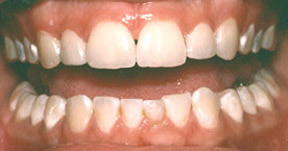
AFTER | Six porcelain veneers were placed and composite bonding was placed on the retained baby tooth. The result of the treatment gave the patient much more confidence in her smile.
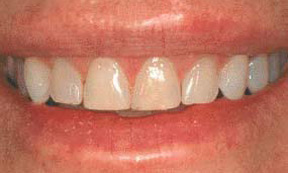
BEFORE | This patient was unhappy with the different colors of her two front teeth. Her left central, the center tooth on your right, was darkened due to a trauma she suffered about 10 years prior to the photo. She also felt that her teeth were too sharp and too short.
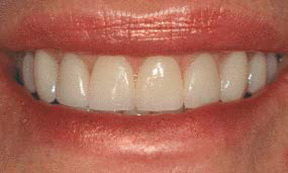
AFTER | Six porcelain veneers were placed that resolved all of the patient’s concerns. The teeth were lengthened so that they are a consistent color and length.
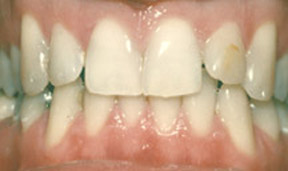
BEFORE | This patient was unhappy with the way the laterals (the smaller teeth next to the two center teeth) stuck out. He also felt that his two center teeth, or centrals, were too long and gave him a Bugs Bunny look. Part of this was due to the laterals not being in the correct position.
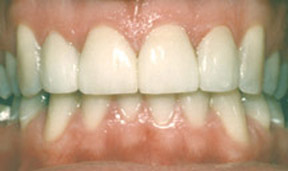
AFTER | The treatment consistent of placing four porcelain veneers on the front four teeth. We added some width to the two front teeth and brought the laterals into alignment. This is a case of instant orthodontics since it took less than two weeks from start to finish.
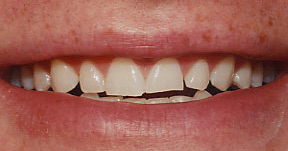
BEFORE | This patient did not like the size and the uneven appearance of his teeth. The unevenness was due to bruxism.
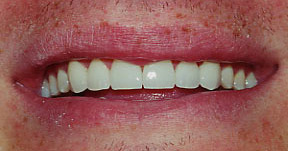
AFTER | The treatment consisted of placing six porcelain veneers on the front six teeth and making a nightguard to not only protect the veneers, but his natural teeth as well.
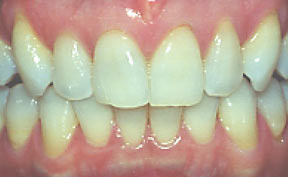
BEFORE | This patient did not like the color, the shape, or the length of his teeth. If length was not an issue, one option would have been to whiten the teeth, followed by orthodontics. Since that would not address the length issue, the treatment of choice was porcelain veneers.
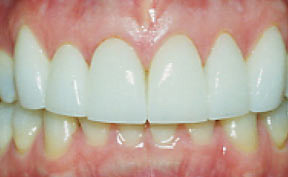
AFTER | Six porcelain veneers were placed and all the goals of treatment were met. The patient was very happy with the color, shape, and length.
Teeth whitening can either be done at home or in our office. The advantage of whitening at our office is that the results are achieved in about one hour. The advantage of whitening at home is that you don’t have to spend an hour in our office. However, it takes from one to two weeks to get the results at home that you get in one hour at our office. Please take a look at the whitening cases to see examples of the type of results we can achieve for you.
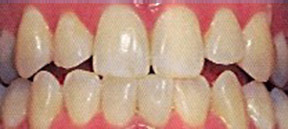
BEFORE | There are two ways to whiten teeth without changing the shape of the teeth. One way is to whiten, or bleach, them at home using custom trays we make for you. The other way is to power bleach them in the office.
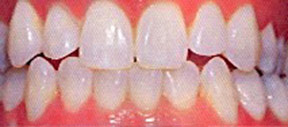
AFTER | The choice in this case was to whiten the teeth at home. This consists of wearing a custom tray filled with a whitening solution for about a two week period. The time it takes to whiten your teeth, and the amount that they will whiten will vary from individual to individual.
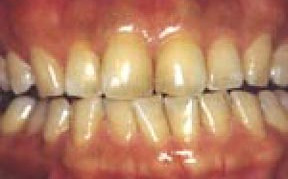
BEFORE | This patient preferred to have her teeth whitened in the office. The procedure required one appointment.
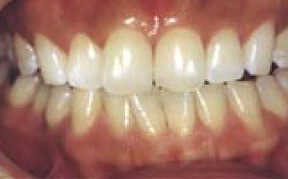
AFTER | The results, in this case, were dramatic. Some sensitivity after the procedure is normal and should disappear in a few days. Results vary from individual to individual.
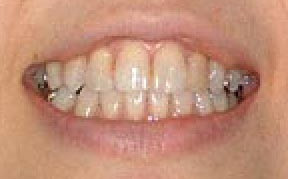
BEFORE | This patient was happy with the shape of her teeth but she did not like the color.
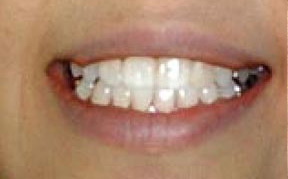
AFTER | She elected to have the whitening procedure done in the office and she was very pleased with the results.









































































































































